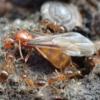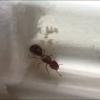my camponotus modoc are also in that lethargic state. I've checked up on them twice since i threw them in the fridge in late october and when i checked on them i notice workers did move around within the tube from the first time i checked to the second, but for the most part they mostly looked dead and fat with their swollen gasters. i noticed some antenna movement on a couple of the workers but i tried to limit how often/long i disturbed them so i quickly put them back. my queen looked the most dead for sure. My fridge is also in the low 40s. don't worry too much, its also my first time.
- Formiculture.com
- Forums
- Gallery
- Members
- Member Map
- Chat























